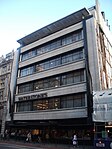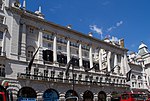Hotel Café Royal
1865 establishments in EnglandFrench restaurants in the United KingdomGrade I listed buildings in the City of WestminsterGrade I listed hotelsHotels in London ... and 3 more
Michelin Guide starred restaurants in the United KingdomRestaurants established in 1865Restaurants in London

The Hotel Café Royal is a five-star hotel at 68 Regent Street in Piccadilly, London. Before its conversion in 2008–2012 it was a restaurant and meeting place known as the Café Royal.
Excerpt from the Wikipedia article Hotel Café Royal (License: CC BY-SA 3.0, Authors, Images).Hotel Café Royal
Sherwood Street, City of Westminster Soho
Geographical coordinates (GPS) Address Website External links Nearby Places Show on map
Geographical coordinates (GPS)
| Latitude | Longitude |
|---|---|
| N 51.51 ° | E -0.13583333333333 ° |
Address
Hotel Café Royal
Sherwood Street
W1F 7BN City of Westminster, Soho
England, United Kingdom
Open on Google Maps








